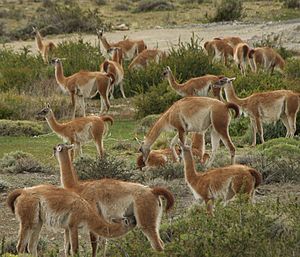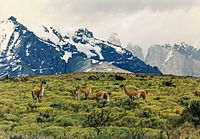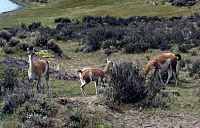Guanaco facts for kids
Quick facts for kids Guanaco |
|
|---|---|
 |
|
| Scientific classification | |
| Kingdom: | |
| Phylum: | |
| Class: | |
| Order: | |
| Family: | |
| Genus: |
Lama
|
| Species: |
L. guanicoe
|
| Binomial name | |
| Lama guanicoe (Müller, 1776)
|
|
The Guanaco (Lama guanicoe) is a type of camelid animal. It lives naturally in South America. Guanacos usually live in small groups or family units.
Contents
Where Guanacos Live
Guanacos live in both the flat Pampas plains and the mountains of South America. You can find them in the high plains (called altiplano) of Peru, Bolivia, and Chile. They also live in Patagonia, and a small group is in Paraguay.
In Argentina and Chile, there are more guanacos in the Patagonian areas. Places like Torres del Paine National Park and Isla Grande de Tierra del Fuego have many of them. In these spots, they have strong populations because farm animals don't compete with them for food as much. In 2011, experts thought there were about 400,000 to 600,000 guanacos. A small group of about 400 guanacos also lives on Staats Island in the Falkland Islands.
Guanacos live in herds. These herds have females, their young, and one main male. Male guanacos who don't have a family group form their own separate herds. Family groups are usually small, with no more than 10 adult guanacos. However, male-only herds can have up to 50 males!
When guanacos feel in danger, they make a loud, high-pitched bleating sound to warn the herd to run away. The main male usually runs behind the group to protect them. They can run very fast, up to 56 kilometers (35 miles) per hour, even on steep and rocky ground. They are also great swimmers. A guanaco usually lives for 20 to 25 years.
Surviving in the Atacama Desert
Some guanacos live in the Atacama Desert, where it hasn't rained for over 50 years in some places. They survive because of a mountainous coastline next to the desert. This creates "fog oases" or lomas. When cool ocean water meets the hot land, the air above the desert cools down. This makes fog and water vapor. Winds carry this fog across the desert. Cacti catch the tiny water droplets, and lichens that grow on the cacti soak up the water like a sponge. When guanacos eat the cacti flowers and lichens, they get the water they need to survive.
-
Guanacos in Torres del Paine National Park in Patagonia
-
Guanacos near the La Silla Observatory, high above sea level.
-
Guanacos near Torres del Paine, Chile
Guanaco Life and Behavior
Natural enemies of the guanaco include pumas and foxes. Guanacos often spit when they feel threatened.
Reproduction and Life Cycle
Guanacos usually mate between November and February. During this time, male guanacos often fight fiercely to show who is strongest and who gets to mate. About eleven and a half months later, a single baby guanaco, called a "chulengo," is born. Chulengos can walk right after they are born! Male chulengos are usually chased away from the herd by the main male when they are about one year old.
Guanacos and People

Even though guanacos are wild animals, about 300 of them live in zoos in the United States. Around 200 more are kept in private herds. Guanacos are also the wild ancestors of the domesticated llama.
Types of Guanacos
There are different types, or subspecies, of guanacos:
- Lama guanicoe guanicoe
- Lama guanicoe cacsilensis
- Lama guanicoe voglii
- Lama guanicoe huanacus
What Guanacos Look Like
A guanaco stands about 1.0 to 1.2 meters (3.3 to 3.9 feet) tall at the shoulder. They weigh between 90 to 140 kilograms (200 to 310 pounds). Their color doesn't change much, unlike llamas. They are usually light brown to dark cinnamon, and white underneath. Guanacos have grey faces and small, straight ears.
Guanacos are one of the largest wild mammals in South America. Other large mammals there include the manatee, the Amazon river dolphin, the tapir, and the jaguar.
Guanacos have thick skin on their necks. Their relatives, the domestic llama, wild vicuña, and domesticated alpaca, also have this trait. This thick skin helps protect their necks from attacks by predators. In Chile, hunting guanacos is only allowed in Tierra del Fuego, where their population is not considered endangered.
Guanaco Fiber
Guanaco fiber is very special because it feels soft and warm. It is used in fancy fabrics. The soft wool of the guanaco is thought to be the second most valuable, after the vicuña's wool. The fur, especially from young guanacos, is sometimes used instead of red fox fur because it's hard to tell the difference. Like their domestic relatives, the llama, guanacos have a double-coat. This means they have coarse outer hairs (guard hairs) and a soft undercoat. The hairs in the undercoat are very fine, about 16–18 microns wide, which is similar to the best cashmere.
Images for kids
-
A guanaco sharing its home with Magellanic penguins in Punta Tombo.
See also
 In Spanish: Guanaco para niños
In Spanish: Guanaco para niños








